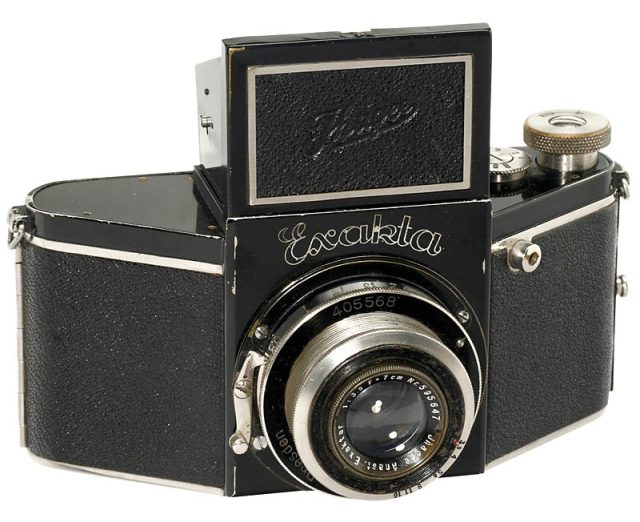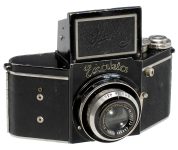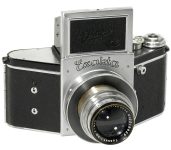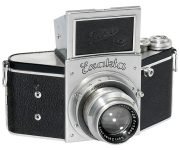Announced
System
VP Exakta system cameras
Exakta A
Medium format MF film SLR camera
Specification
| Format: | |
| Medium format 6.5x4 | |
Film type: | 127 roll film |
| VP Exakta | |
| Shutter: | |
Type: | Focal-plane |
Model: | Mechanical |
Speeds: | 1/25 - 1/1000 + B, Z |
| Exposure: | |
Exposure metering: | None |
Exposure modes: | Manual |
| Physical characteristics: | |
Weight: | 750g |
Dimensions: | 150x65x50mm |
Manufacturer description #1
Exakta is an unusual novelty in the field of miniature cameras. Its design is such that it gives the maximum camera effectiveness in the smallest possible space.
It is a mirror reflex using roll film 1 5/8 x 2 1/2 inches, which is commonly used in all Vest-Pocket cameras, and is usualy supplied 8 exposures to the roll. Most miniature cameras that do not have the reflex feature do not possess the exactness of focus of the Exakta. With this camera it is not necessary to use either a depth of focus scale or a distance meter. When examining the image on the ground glass one can determine the exact depth of focus that the lens gives and use the diaphragm accordingly. This feature makes it possible to focus and compose the image much more satisfactorily than with the small finders usually supplied on Miniature cameras. It is also possible to examine the image up to the very last second before making exposures. The film spool and focal plane shutter with which this camera is equipped are synchronized so that it is impossible to make a double exposure.
The long experience of the makers of this camera in constructing mirror reflex cameras has stood them in good stead in perfecting this instrument.
Manufacturer description #2
The "Exakta" being a direct Reflex Camera, the picture seen in the finder mirror is exactly the same as the one the lens will produce on the film, exact size and exact in detail. The same knob that winds the film to the next number also sets the shutter, and double exposures are quite impossible.
In the Model A the Ihagee Patent Safety Blind Focal Plane Shutter allows for speeds from 1/25th to 1/1,000th second, also time and bulb. The Model B is fitted with an extra control giving instantaneous exposures from 1/25th ot 1/1,000th second, short and long time exposures from 1/10th, 1/2 to 12 seconds. Delayed action release for exposures from 1/1,000th to 6 seconds. The delayed action control allows 12 seconds to elapse after the release has been pressed before the shutter operates.
In addition to the direct reflex image the picture can also be seen at eye level by means of an auxiliary mirror; and a magnifier is incorporated for extra fine focussing, also frame finder for use when necessary.
The focussing is effected by a rapid Helical Screw and the scale is engraved from infinity up to four feet.
Body made entirely of metal, leather covered, with spring safety cover to the film recording aperture, for use with Panchromatic films, and fitted with Tripod Bush and Cable Release.
Manufacturer description #3
Focal plane shutter, self-capping, instantaneous speeds from 1/25th to 1/1000th sec. can be read at once, time exposures for any length. Interchangeable lenses.
From the Classic Camera magazine (November 2002)
In 1932, the same year it was celebrating its twentieth year of activity in its headquarters in Marcolini Strasse in Dresden, Johan Steenbergen's Ihagee company began production on an extraordinary reflex camera for 127 roll film in the then-popular 6.5x4cm format known as Vest Pocket.
The camera was officially presented to the public at the LeipzigerMesse in 1933 with the name Exakta and was equipped with a folding waist level finder, focal plane shutter, speeds up to 1/1000 sec and removable lens. The Exakta offered a number of new and interesting structural features, both from a technical/functional point of view as well as in its appearance.
The Exakta was designed by Karl Nuchterlein for Ihagee on the basis of a number of very original ideas that took root quite independently from the roll and plate reflex cameras available on the market in the late 1920s. The Exakta was different from the ungainly Ensign Roll Film Reflex made by the English firm Houghton, and was very different from the twin-lens reflexes so tremendously popular at the time. Compared with Ihagee's traditional reflex output - the folding Klappreflex for 6.5x9cm to 10x15cm plates, the Nachtreflex for 4.5x6cm or 6.5x9cm plates and the economical 6x6cm Roll Paff - the Exakta represented a major leap in quality. Exakta's original features included the choice of roll film instead of plates and, above all, 127 film which was much narrower than 120 roll film. Even the choice of the long, narrow 4x6.5cm Vest Pocket format that did not correspond with any print paper size was something new compared with the traditional square format of the Rolleiflex and perhaps drew on the success of the similar Leica format. The Exakta was designed without taking into consideration the problems of taking vertical shots and the paper wastage already evident in the Leica 24x26mm format. Finally, the Exakta was original for the layout of its main controls, such as the wind button and shutter speed dial on the left side of the top plate instead of the right. The shutter release button was placed in the unusual position on the front of the camera, but always on the left. Seemingly designed for left-handed photographers, the Exakta was particularly flat and elongated in shape with the two sides of the front sharply slanted towards the front lens panel. The camera had an unusual trapezoid prism shape with the shorter base towards the front. This shape was never imitated by any other camera and, in the end, was what distinguished the entire line of Exakta reflex cameras, whether Vest Pocket or 35mm format. The same shape was firmly adhered to for the Exakta 35mm cameras produced in the post-war period up to the early '70s.
Light and manageable, the Exakta was equipped with a large folding waist level finder, focal plane shutter in rubberized silk and a lens equipped with a large focusing helical with infinity locking lever. The lens mount thread size was 39.5mm with a pitch of 0.5mm, fairly similar to that used on the Leica. At time of purchase, the buyer could choose from five different 75mm focal length lenses: an Exaktar, a Primotar or a Tessar with a speed of f/3.5, or a f/2.8 Xenar or Tessar. The lens was removable but not interchangeable due to the lack of alternative focal lengths, and the possibility of mounting lenses by other manufacturers or with different speeds, was more of an advantage for the manufacturer or dealer than the photographer. The back of the Exakta could be opened from the side with a latch on the right and had the classic red window to check film advance and frame count. The camera body, like most cameras of the era, had a black paint finish.
Over the course of 1933, two versions of the Exakta VP were produced simultaneously that were identical in appearance but with different features and price tag. The first Exakta was identified as the Exakta A with seven shutter speeds (1/25, 50, 100, 200, 300, 600 and 1000 plus B and time exposure settings) and with the right side of its top plate completely smooth, without any controls. The second Exakta was called the Exakta B and had the same shutter speed dial, but on the opposite side of the top plate it had a large knob used to select slow speeds from 1/10, 1/2 and 1, 2, 3, 4, 5, 6, 9, 10, 12 seconds. The same knob was used to load the self timer with up to a 6 second delay. These two Exaktas were manufactured in parallel for all of 1933, but the next year both were replaced by two cameras that offered the same shutter speeds, but with a fast wind lever instead of the clumsy knob. Above all, the 1934 Exaktas were equipped with a new screw mount for lenses just slightly wider than before, 39.8mm, and more solid with a pitch of 0.75mm. The new mount made it possible to interchange lenses and mount an entire series of fast lenses and telephoto lenses on the Exakta. In addition to these technical changes, there were also some styling modifications. Although the controls remained on the left front, the infinity locking lever was moved to the left of the lens changing catch. On the finder cover next to the Ihagee name, the company logo - a small sun inside of a half-moon - was engraved. At virtually the same time, the back was modified with a sliding door to protect the red window that was only opened to check the film advance. These changes were not made at the same time or all together, so it is possible to find Exakta cameras with the old wind knob and new lens mount, or with the release lever on the right and new type of back, or vice versa. Collectors have identified various versions of the Exakta A and B manufactured over the years 1933 and 1934, all characterized by the lack of the synch sockets on the front.
In 1935, Exakta output was updated with the addition of a two pin socket on the front for use with a Vacublitz flash. This was something entirely new in the camera field and the Vacublitz company released a series of reflectors with flash bulbs designed and created expressly for use with the Exakta Vest Pocket. The Exakta A, Exakta B and Exakta Night made use of this attractive feature in the new models built between 1935 and 1936. The two pin socket was modified in 1937 with the addition of a third hole aligned vertically with the synch sockets, but, unlike the latter, was not an electrical contact, merely a mechanical connection for the flash arm. Beneficiaries of this feature were the Exakta B and Exakta Night, but the same type of contact can also appear on the more economical Exakta A and was even used on some Exaktas made before 1935.
The rapid proliferation of its models and variants was symptomatic of a period characterized by rigorous experimentation and technical progress and the Exakta Vest Pocket left its mark on a short but intensely-active era that, unfortunately, was interrupted by the tragedy of the war. The Exakta Vest Pocket remained in production for just eight years, perhaps until 1940, handing over its legacy in full to the small Kine Exakta for 35 mm film. With war imminent, production of the Exakta Vest Pocket was halted, never to be restarted. Despite the fact that the Exakta VP offered performance levels that, in terms of lens speed, were equal to the Ermanox, in terms of versatility to the Leica and for precision to the Rolleiflex, in the post-war period there was no one willing to continue their production or imitate them, either in Germany or elsewhere. During the 1930s, the Exakta VP was flanked on the market by just a few reflex cameras with larger format, such as the Primarflex and the Reflex Korelle, characterized by a 6x6cm square negative, not to mention the twin reflexes such as the Rolleiflex, Ikoflex and Superb, also with 6x6cm square format. Even if this competition made things difficult for the Exakta Vest Pocket, it should not be forgotten that, towards the end of the Thirties, lhagee heard the siren call of the 6x6cm format, offering a giant, 6x6cm format Exakta that competed with its own Exakta Vest Pocket.
However, with the close of the 1930s, it seemed that the Exakta Vest Pocket had exhausted all its potential while the life cycles of the single lens and 6x6cm twin-lens reflexes continued to develop after the war. The Rolleiflex and lkoflex survived, as did the Primaflex and Korelle, and even lhagee allowed itself to be seduced a second time by the 6x6cm format, presenting in the early 1950s an ill-fated 6x6 reflex named Exakta, but completely different from either the Exakta Vest Pocket or the pre-war 6x6 Exakta. In fact, after the war, Ihagee concentrated its efforts primarily on the Exakta 35mm while completely (and definitively) leaving aside the larger formats, above all the 4x6.5cm Vest Pocket format.
Original, imaginative and versatile, the Exakta Vest Pocket remained the symbol of a courageous and diversified approach to camera production, despite its relative lack of success. Thanks to the numerous and complex variations in its output, the Exakta Vest Pocket models have become splendid and much sought-after pieces for collectors.



